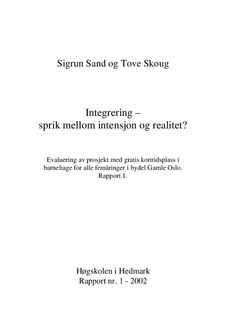| dc.contributor.author | Sand, Sigrun | |
| dc.contributor.author | Skoug, Tove | |
| dc.date.accessioned | 2012-05-08T13:12:57Z | |
| dc.date.available | 2012-05-08T13:12:57Z | |
| dc.date.issued | 2002 | |
| dc.identifier.isbn | 82-7671-193-6 | |
| dc.identifier.issn | 1501-8563 | |
| dc.identifier.uri | http://hdl.handle.net/11250/134026 | |
| dc.description.abstract | Rapporten er den første av to rapporter fra evalueringen som Høgskolen i
Hedmark har gjort av prøveprosjektet ”Tilbud om gratis korttidsplass i barnehage for alle 5-
åringer i bydel Gamle Oslo”. Oppgaven vår har vært å vurdere om prøveprosjektet legger til
rette for bedre språkopplæring og bedre integrering. Det er hovedsaklig minoritetsspråklige
barn som benytter dette korttidstilbudet som har som målsetting å øke barnas
norskkunnskaper før skolestart. Vi gir en beskrivelse og vurdering av det pedagogiske
opplegget i prosjektbarnehagene samt i tre andre barnehager i bydelen. Vi presenterer også
resultatene fra en språkscreeningstest som gir et bilde av den norskspråklige utviklingen hos et
utvalg av de minoritetsspråklige barna. Til slutt i rapporten drøfter vi hvordan prøveprosjektet
kan sies å ha lagt til rette for utvikling av barnas andrespråkskompetanse og for bedre
integrering. Vår undersøkelse av barnehagene som språkopplæringsmodeller, viser at alle
prosjektbarnehagene var organisert og lagt opp etter en assimilerende modell som fremmer
énspråklig på norsk. Det var kun én barnehage i vårt utvalg som hadde en opplæringsmodell
som fremmer tospråklighet og integrering. Resultatene fra språktesten viser at de fleste av
barna i utvalget hadde framgang i norsk språk i løpet av det året de gikk i barnehagen. Når det
gjelder oppnådd nivå, viser resultatene imidlertid at de fleste av barna kommer til skolen med
langt svakere norskspråklig kompetanse enn det énspråklige jevnaldringer med norsk morsmål
har. Et sentralt spørsmål blir derfor hva slags undervisningssituasjon barna møter i skolen.
Resultatene viser at nesten alle som ble språktestet vil ha behov for særskilt språkopplæring.
På bakgrunn av undersøkelsen har vi grunn til å anta at de minoritetsspråklige barna har
profitert på tilbudet i barnehagen, både språklig og sosialt. Slik personalet i
prosjektbarnehagene har iverksatt sine språkopplegg, synes barnas motivasjon til å tilegne seg
norsk å ha blitt godt ivaretatt. Men en vesentlig svakhet ved tilbudet er at barna ikke har hatt
muligheter for å inngå i sosial samhandling med etnisk norske barn. Med barnegrupper
bestående av både minoritets- og majoritetsspråklige barn og med et pedagogisk program som
i større grad var preget av et flerkulturelt innhold, mener vi at prosjektbarnehagene ville vært
mer i samsvar med prøveprosjektets intensjoner om bedret norskopplæring og integrering. | no_NO |
| dc.description.abstract | English: This is one out of two evaluation reports of the pilot-project “Short-time
kindergarten free of charge for all 5-years-old children in Gamle Oslo”. The evaluation has
been carried out by Hedmark College at the request of the Ministry of Children and Family
Affairs. Our task has been to describe and evaluate whether the pilot-project promotes the
minority children’s language skills and their integration. Mainly children from different ethnic
minority groups are making use of these short-time kindergartens whose object first of all is to
promote the children’s second language skills (Norwegian). This report describes and
evaluates the education program in all the “Project Kindergartens” and in three other
“external” kindergartens within the district. We have tested a group of children in order to get
a picture of their progress in their second-language skills. The results are presented in this
report. Finally we discuss how the educational program in the “Project Kindergartens” seems
to promote the children’s skills in the Norwegian language and how the program contributes
to the integration process. Our investigations show that on the institutional level all the
project-kindergartens had a type of educational program with monolingualism (in Norwegian)
and assimilation as language outcome and educational and societal aim. Among all the
kindergartens investigated only one seemed to follow a type of program with bilingualism as
language outcome for the children and pluralism/integration as a societal and educational aim.
Most of the children who went through the screening test showed progress in their language
skills in Norwegian during the year. But even so they were far behind the level of their ethnic
Norwegian peers. This actualises the question of how the school will meet these children’s
need. Our results show that most of them are in need of a special language education program
in school. All the minority children seemed to benefit, both linguistically and socially, from
their stay in the “Project Kindergartens”. The way the staff carried out the education program
in practice seemed to keep up the children’s motivation for second-language learning. The
lack of ethnic Norwegian children in the groups, though, was a weak point of great
importance. With children from both minority groups and the majority group together within
the class using a multicultural curriculum, the “Project Kindergartens” would be more in
accordance with the pilot-project and its main intention of improving the second-language
education and integration. | |
| dc.relation.ispartofseries | 1;2002 | |
| dc.subject | barnehage | no_NO |
| dc.subject | minoritetsbarn | no_NO |
| dc.subject | integrering | no_NO |
| dc.subject | norsk som andrespråk | no_NO |
| dc.title | Integrering – sprik mellom intensjon og realitet? | no_NO |
| dc.title.alternative | Evaluering av prosjekt med gratis korttidsplass i barnehage for alle femåringer i bydel Gamle Oslo. | no_NO |
| dc.type | Research report | no_NO |
| dc.source.pagenumber | 198 | no_NO |
